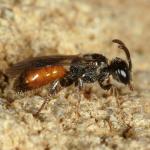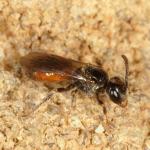Sphecodes nitidulus VON HAGENS 1882
A southern species, this bee is found from Hampshire to Kent, north to Norfolk with limited information from south Wales and an isolated location in the north Midlands. Not so far found in the Isles of Scilly.
Abroad, this is a Western Palaearctic bee found locally in central and southern Europe, and in North Africa.
Listed in Falk (1991) as Notable A (now known as National Scarce).
It is mainly associated with dry, sandy heathland and other disturbed sandy situations such as sandpits. Occasionally found in open, broad-leaved woodland.
Univoltine. The female flies from late April to late September and the male from July (perhaps June) to early September.
A cleptoparasite of mining bees of the genus Lasioglossum. The female has been seen near the nest burrows of potential hosts. That usually quoted is L. minutissimum (Kirby) but it may also parasitise L. morio (Fabricius) and L. leucopus (Kirby). Details of the parasitic behaviour remain unrecorded.
The bee has been found taking nectar on wild angelica and wild carrot (Apiaceae), and various Asteraceae such as thistles, yarrow, mayweed and common ragwort.
No data available.
2019



